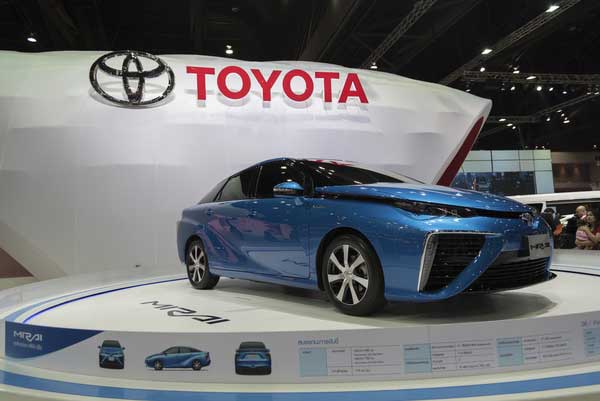In a world dominated by electric vehicles (EVs), Toyota has taken a bold step towards revolutionizing the automotive industry. Their latest innovation, a zero-emission hydrogen-powered vehicle, promises to challenge the EV status quo. In this article, we delve into the details of Toyota’s journey in the hydrogen vehicle segment, explore their latest offerings, and discuss the environmental benefits of hydrogen-powered vehicles over EVs.

Toyota’s Hydrogen Journey
Toyota’s foray into hydrogen vehicles dates back to 1992 when they embarked on the development of hydrogen-powered technology. In 1996, they unveiled their first fuel cell electric vehicle (FCEV) prototype, based on the Toyota RAV4. This marked the beginning of a two-decade journey of innovation and experimentation that ultimately led to the launch of the first-generation Toyota Mirai in 2015. The Mirai was a milestone as it was the first commercially sold hydrogen-powered vehicle.
The Evolution of Mirai
The first-generation Mirai, although limited in sales to Japan and California, proved successful in real-world scenarios. Toyota’s hybrid technology formed the foundation of the Mirai, making it a significant step towards greener transportation. Building on this success, Toyota introduced the second-generation Mirai just two years ago. Unlike its predecessor, this version is a luxurious sedan that offers comfort and elegance. Sales have surged globally, with tens of thousands of Mirais now on the road.
Toyota’s Two New FCEVs
Toyota has now announced not one, but two new FCEVs to expand their hydrogen vehicle lineup. First, they plan to redesign the Mirai, addressing previous issues like cramped interior space due to hydrogen tank placement. Additionally, they will introduce the Toyota Mirai Sport, featuring a striking and sportier design, with enhancements such as redesigned bumpers, black trims, and carbon-style body panels. The Mirai Sport promises an engaging driving experience with larger alloy rims and Michelin Pilot Sport S tires, along with a lowered suspension for improved handling dynamics.
Powering the Future
The new Mirai Sport is expected to have more than 220 horsepower, offering better acceleration, and potentially achieving 0 to 60 mph in under 7 seconds. While it might be less efficient than the long-range Mirai, its projected 402-mile range is still impressive. But the Mirai isn’t the only FCEV on Toyota’s horizon; they are also introducing the all-new Toyota Crown sedan, a longer and more luxurious vehicle that shares a platform with the Mirai. With China expressing strong interest in the Toyota Crown, the future of hydrogen-powered vehicles looks promising.
Environmental Benefits of FCEVs Over EVs
Now, let’s address the key question: why choose hydrogen-powered vehicles over EVs? One of the most significant advantages is their environmental impact. While EVs don’t produce tailpipe emissions, the energy they require often comes from environmentally damaging sources. In contrast, FCEVs use hydrogen, the most abundant gas in the universe, and don’t rely on grid charging. This makes them a greener option in the long run.
Moreover, EV batteries, primarily composed of toxic lithium, harm the environment during both production and disposal. In contrast, FCEV batteries are more environmentally friendly, using fewer toxic materials. FCEVs also recycle air through their filtration systems, contributing to cleaner urban air.
The Economic Aspect
Another compelling aspect of FCEVs is their cost-efficiency. With hydrogen’s virtually endless supply, recharging FCEVs can be extremely affordable, possibly making them one of the most economical transportation options in the future. However, the current cost of hydrogen production and storage poses challenges. Hydrogen infrastructure and the need for frequent tank replacements also require addressing.
The Road Ahead for FCEVs
While FCEVs hold promise, they face significant challenges, such as limited infrastructure and the cost of hydrogen production. In contrast, EVs are more established and widespread. Toyota’s commitment to both FCEVs and EVs demonstrates a diversified approach to sustainable transportation. The transition to cleaner mobility options, whether hydrogen-powered or electric, is essential for a greener future.
Conclusion
In conclusion, Toyota’s new hydrogen-powered vehicles represent an exciting shift in the automotive industry. As they strive to overcome challenges and refine their technology, the potential benefits of FCEVs over EVs become increasingly evident. Whether you prefer the redesigned Mirai or the luxurious Crown sedan, Toyota’s commitment to a greener future is commendable. The choice between hydrogen and electricity may define the future of transportation, and Toyota is determined to be at the forefront of both revolutions.
